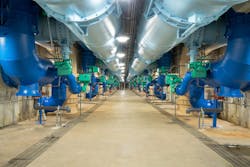Lighting Retrofit Improves Visibility at Water Treatment Plant
In 2015, the facility management team at the A.B. Jewell Water Treatment Plant, located in Tulsa, Okla., had grown tired of the expense and maintenance of dealing with their outdated lighting system. Consisting of 350 fixtures, lighting in the facility included metal halides, high-pressure sodium, and T12 fluorescent lamps ranging from 70W to 400W. Only two electricians were available to work on all of the projects within the facility, so troubleshooting failed fixtures was a waste of time and money.
“It’s an important element of the facility — we cannot have lights out. But, some of the fixtures were in a position where we couldn’t even get to them. It was becoming a real problem,” says John Curry, maintenance supervisor at the facility. “Anyone can change a light bulb. We need our electricians to be working on bigger projects, and other projects were getting put off for lighting maintenance.”
In addition, the dingy, distorted color of the metal-halide and high-pressure sodium lights also caused visibility issues. Workers had a hard time distinguishing between green and blue colors on various pump motors and visually inspecting the water to detect septic conditions.
The plant facility management team ultimately decided on Dialight LED streetlights, high-bays, low-bays, flood lights, and area lights to replace the plant’s current system. A total of 259 fixtures (ranging from 33W to 212W) were used, both reducing the total fixture count and slashing 446,576kWh from the plant’s annual energy consumption.
The project also qualified A.B. Jewell for a $32,000 rebate incentive from its energy provider, the Public Service Company of Oklahoma, which covered almost 20% of the retrofit’s cost and brought the payback period from 8.1 years to 6.6 years.
“It’s been a complete 180,” said Curry. “You can actually see into the equipment pits, and even the contractors that were here before the lights were switched out are so impressed. We get compliments from the guys working in the building, and morale is definitely higher.”
Six years later, Curry still considers the retrofit a sound time- and cost-saving investment.
“We’ve been able to decrease the amount of lights in some areas of the facility, cut our maintenance costs by $6,000 to $7,000 per year, reduce our energy costs, and improve our light levels,” he added.
